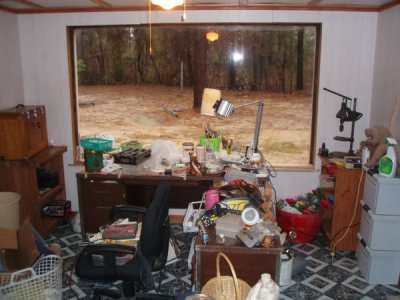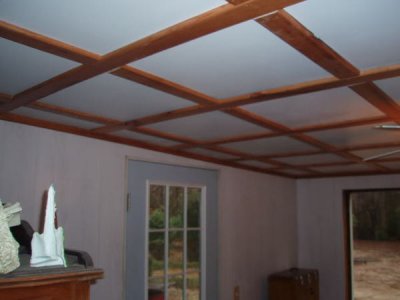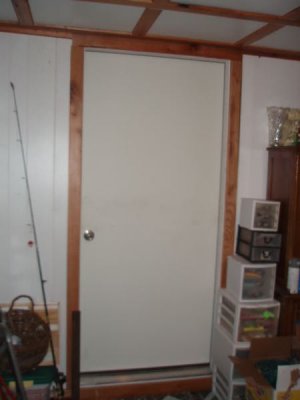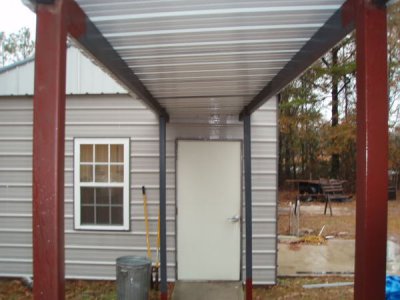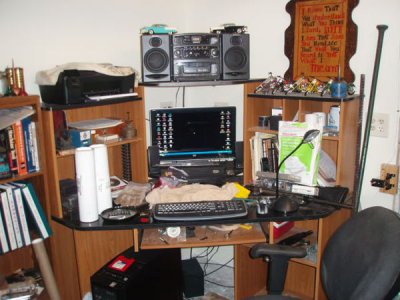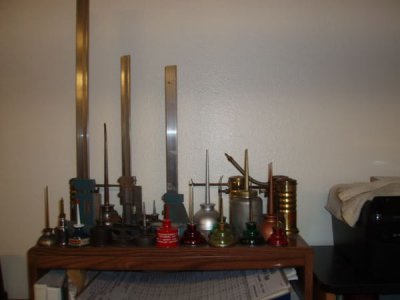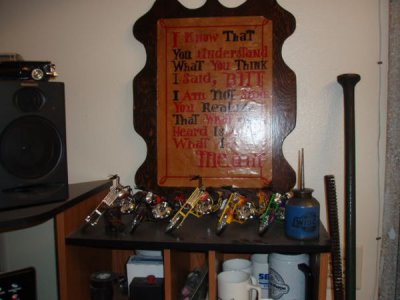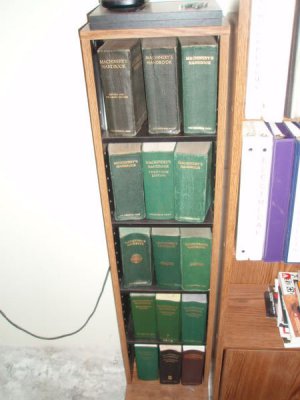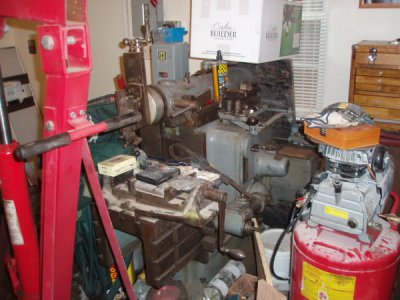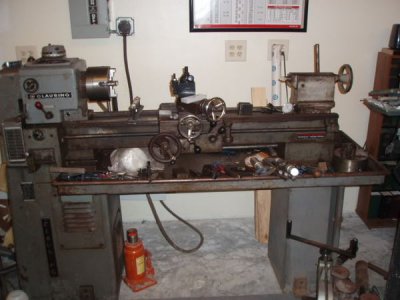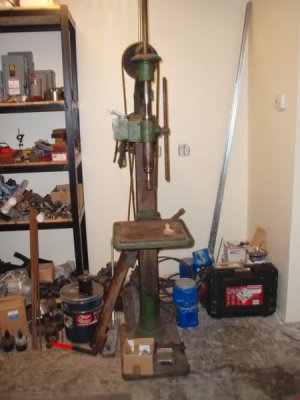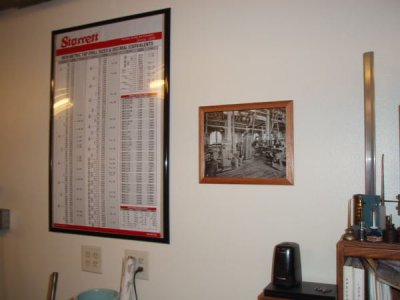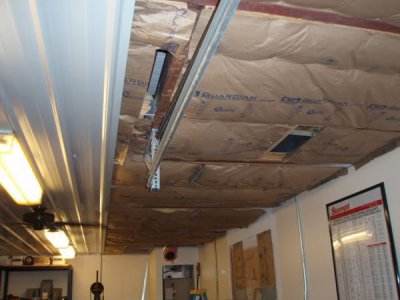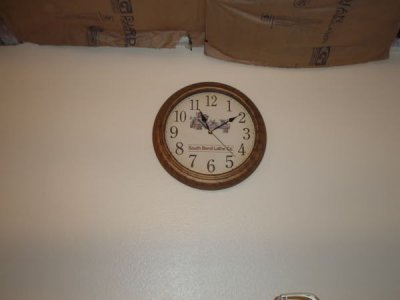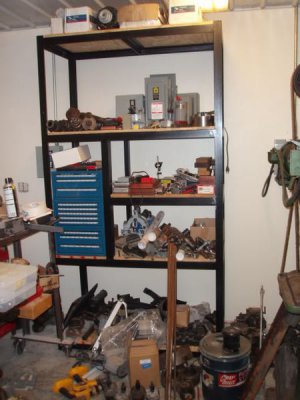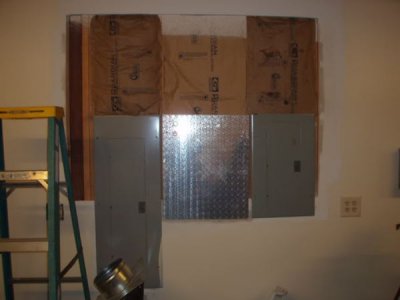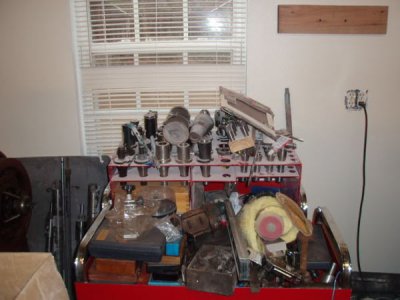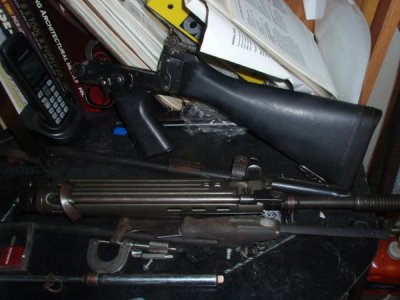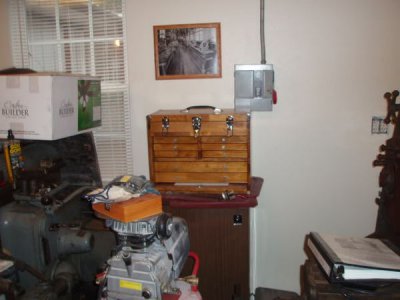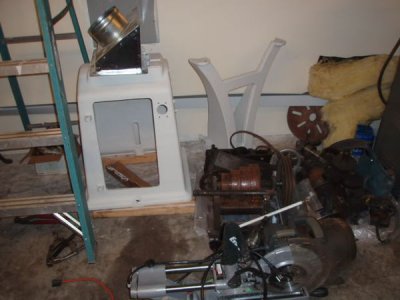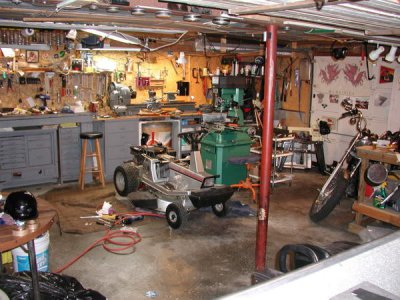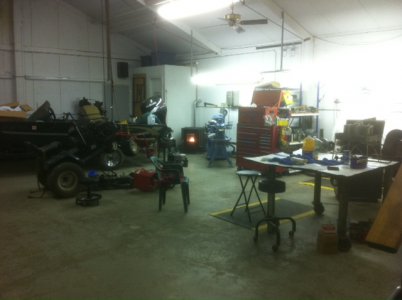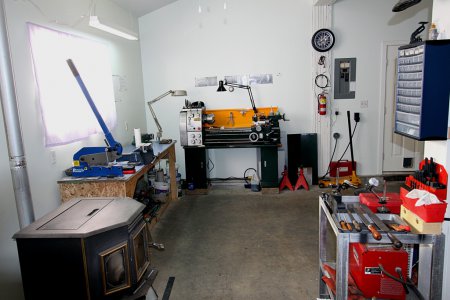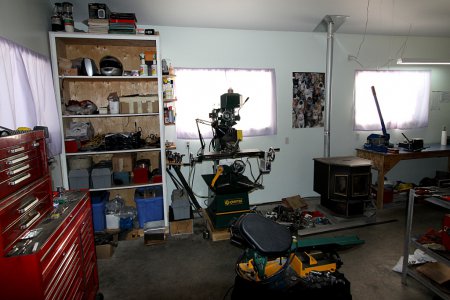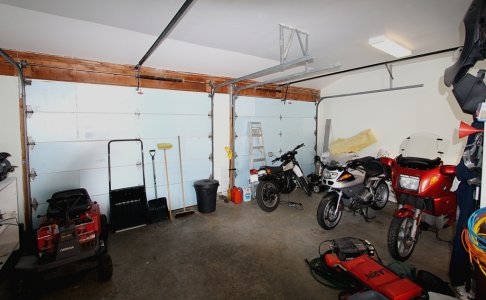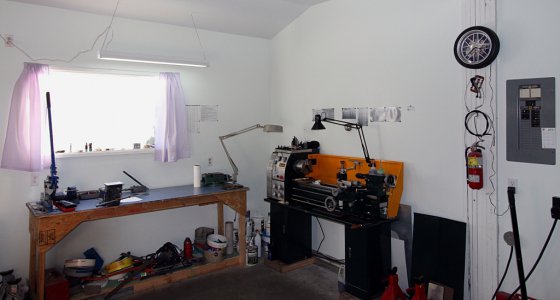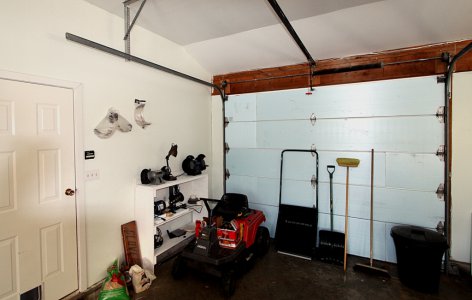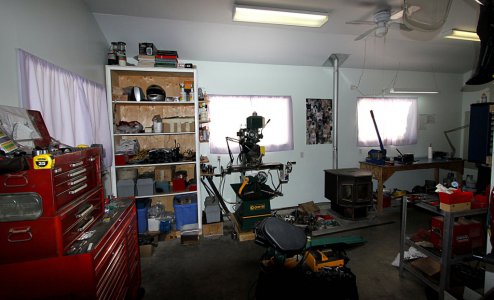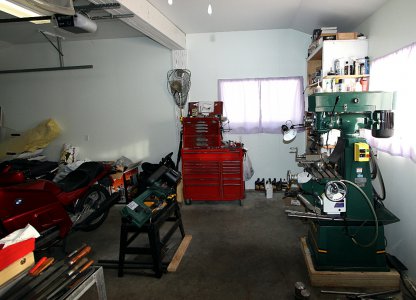It's a mite crowded in my shop:
The venerable work bench, neat as usual:
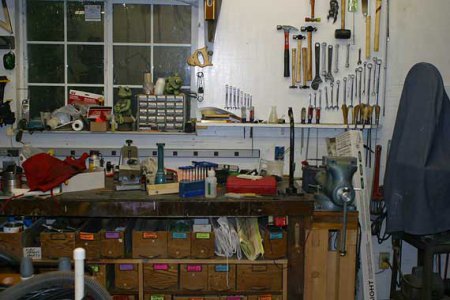
And, of course, the tool drawers:
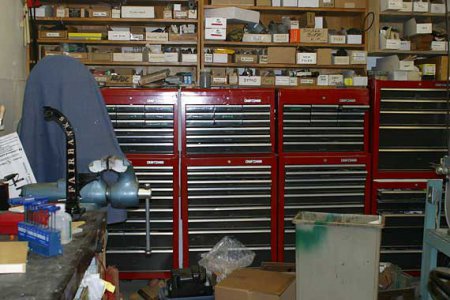
The old wood cutting band saw - my first power tool bought in 1969 with the proceeds from my first guitar sale:
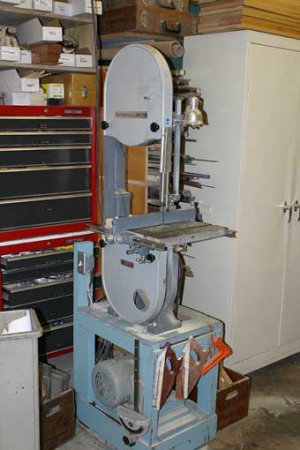
After 35 years it's still on its "temporary " stand. . .
Grizzly 6" belt/disc sander and the ever useful 1x42 sander:
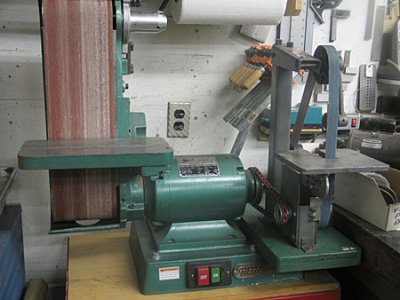
I bought the slow version (2500 sfpm) Grizzly 6x48 belt and disc sander combo. After having the machine for a couple of years I realized that I never used the disc, so in late May, 2006 I took that part off stuck on a v-belt pulley and added my 1x42 sander onto the right end of the base. The 1x42 sander is clearly the most used power tool in our guitar shop, and my home version has served me well for 30 years at least.
Moving the small sander freed up some bench space, and in the process, I actually cleaned my bench and slopped on a new coat of epoxy. I won't be getting used to this sight:
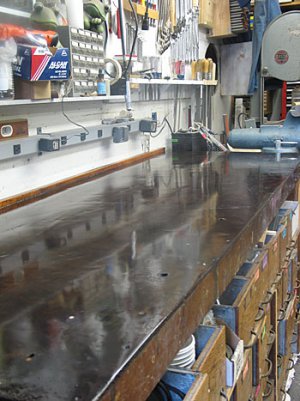
By the next day, the bench was covered with crapola, as usual.
Big Grizzly drill press. Hefty and strong, it does a job:
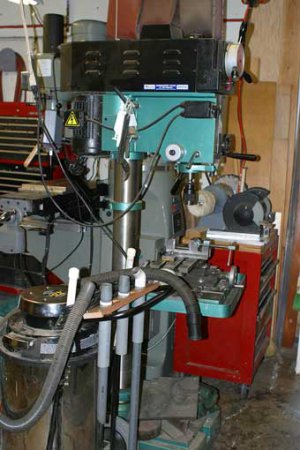
I finally jettisoned the Craftsman one with the wonky spindle in 2002. In the foreground is my most recent shop vac, and the first one I
really use. It has a very quiet motor and 1-1/2" hose that's easy to handle. I've made an assortment of PVC "wands" which I find much more useful than the tools that come with these things.
1943 (part of the War Effort) Delta metal cutting band saw:
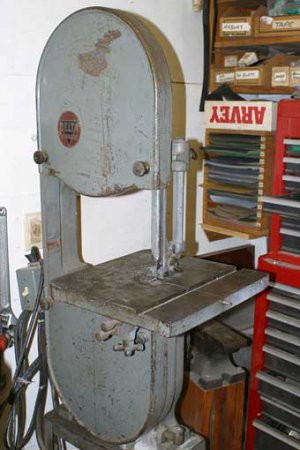
I got this one in about 1975 by dumb luck in a want ad.
Rusnok:
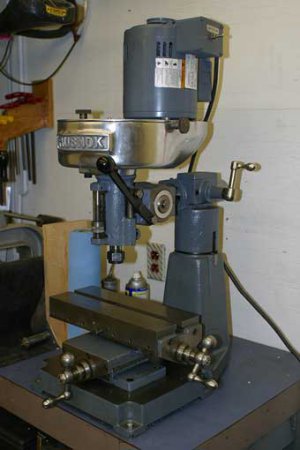
Until 2004, my only mill. It's a great small tool, made in Milwaukee. Not cheap, but cool and really handy for small jobs.
Qunicy in the corner:
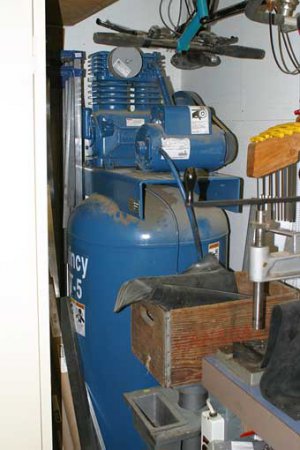
In retrospect, I'd have gotten a single stage unit, but this one puts out all I need for air sanders, so I have no real complaints.
Cheesy Sears grinder (the next tool on the "hit" list) and Baldor buffer:
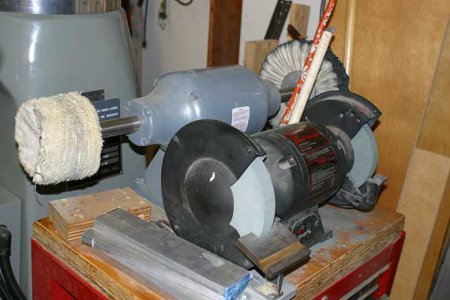
They're wired from overhead, and I just spin the cabinet around to use the buffer.
The big guy, Sharp 9x42 mill, digital variable speed, DRO, power drawbar, etc:
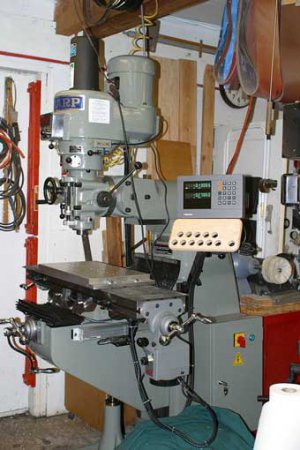
It's great having a full size mill. And, with DRO, I've quit thinking about backlash in table screws.
The photo above was taken just after I got the mill in 2004, when the shop wasn't nearly as full as it is now. Here's how the mill looks in 2009:
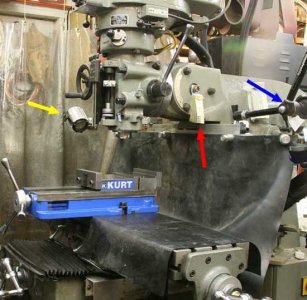
You can see that
my rubber sheeting shields every sliding part from chips i t's held up by magnets, as are lots of things in my shop. I routinely get into milling stuff that leaves a big mess, such as wood, plastic and cast iron, and with the ways so completely covered I don't have to worry about clogging things up with abrasive swarf. Also visible is my plastic sheet curtain that hangs behind and to the left of the mill, allowing me to blow off chips with compressed air from the right side, where I'm typically standing. The chips hit the curtain and fall "neatly" to the floor."
That's my new
swing arm lamp at the yellow arrow. It's bigger than it looks in this photo because it's moved far to the left. It mounts on the
light bar, as does the rubber sheeting. The red arrow points to
my cigarette paper substitute - .002" thick pieces of a phone book. The blue arrow indicates the
Magic Arm, a camera accessory that has a quick-mount plate system. I made extra plates so I can have clamps, air blower, vacuum or other accessories mounted for easy positioning when I need them for milling operations.
And, the star of the show, Sharp 1118H high precision toolroom lathe:
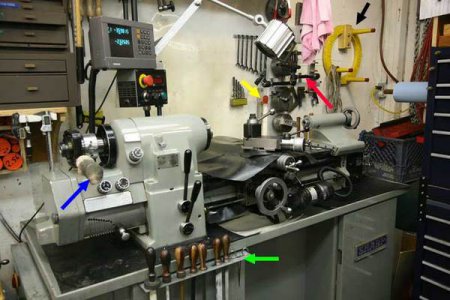
I have the lathe right up against the wall, which has some plastic sheeting stapled on, and tucked into the chip pan. That way, any chipsor small parts hit the wall and drop into the pan rather than falling into the abyss behind a heavy tool. Up to the left is a Kennedy box filled with gauges, indicators, mics, etc., below which are hanging the digital caliper and micrometer I use most often.
You can see the dirty sock cover on the collet closer. Most of my work is less than an inch in diameter, so collets get a good workout. I have an assortment of chucks as well, some of which are hanging on the wall behind the tailstock. Most of them are cut off in the photo, but you can see the wood handles of my
"simple lathe spindle tools"along with swarf pickup tools and a couple of files - just some items that make life a bit easier. The yellow arrow points to the
lathe file that sits in an oil bath - a
Guy Lautard idea. At the back end of that same yellow arrow is a rack of common size drill bits for making quick holes.
Mounted on the wall and at the point of the red arrow is another Magic Arm - the one I use mostly for holding a camera when photographing lathe operations
Jammed in the corner against the big door is my 1976 Rockwell/Delta Unisaw:
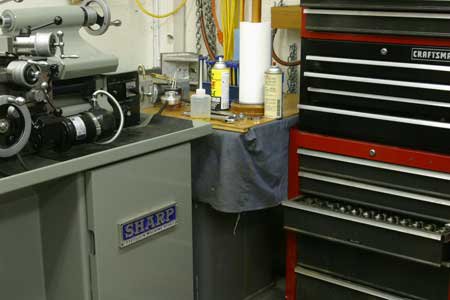
Mostly, it's a Uni-utility-table, but it still gets some exercise out on the driveway were I can take advantage of "nature's dust collector."
I'd never want to be without a Versa Vise:
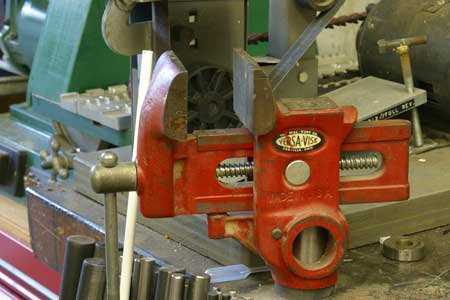
Positively the most handy and useful light duty workholding de-vise
. Here's more about this tool, should you care.
A couple of years ago I made up a pair of these light standards for doing photography of my work and
Joy's pottery:
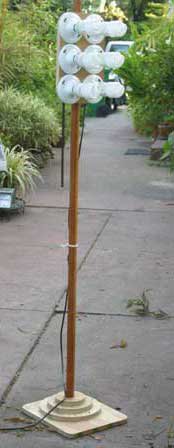
It has six of those twisty 26-watt fluorescent bulbs that are supposed to replace 100 watt incandescents, and gives a strong even light. I recently discovered that this portable light makes a great worklight for sensitive jobs. I can just walk it over to the mill or lathe and get the equivalent of 600 watts of firepower to light up the area.
It doesn't get really cold around here, but we do have our nights down to about 30 degrees Fahrenheit, so I've struggled with heat in this old garage, and finally came up with a great solution to the problem. I got a pair of these 3000 watt quartz radiant heaters from MSC, and stuck them up near the 9-foot ceiling:
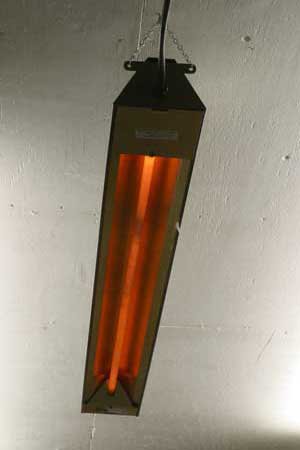
Not wanting to spend a lot of $$ on heat, I figured I'd have them on only when I was actually in the shop, so I switched them individually and wired them through a spring wound heavy duty timer:
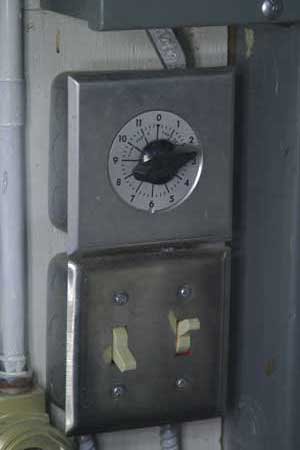
Now, I can walk into the cold shop, twist the timer for an hour or so, and the heaters warm me directly without having to cook the entire contents of the building. If I forget to turn them off, the timer takes care of that for me. Really, there's no point in having a thermostat.
Recently I decided that it would be interesting to get a sense of exactly how much time I spend in my home shop, so I installed this hour meter on the light circuit:
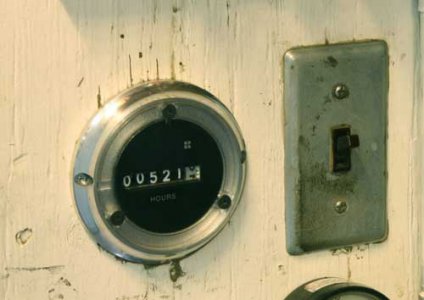
I hope this resolves any question about my tenuous hold on sanity. . .
Here's a great old 8" diameter certified pressure gauge I found at a garage sale:
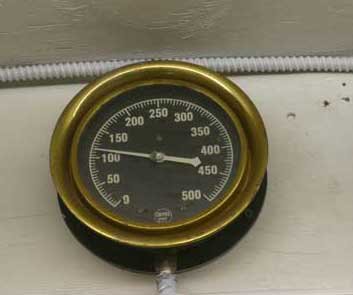
I have it mounted near the ceiling so I can see my air line status at a glance. Another "just for fun" item, of course.
And, to keep sane, I have my tunes:
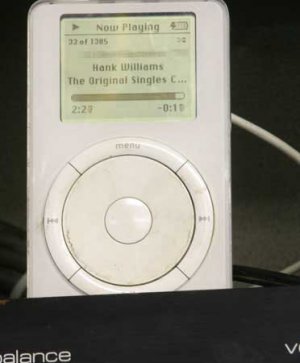
Stuck on top of an old stereo amp and set on random play, I have my music whenever NPR isn't what I want to listen to.
